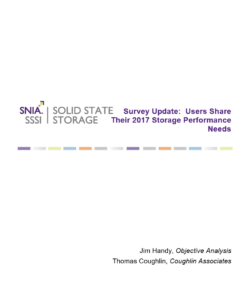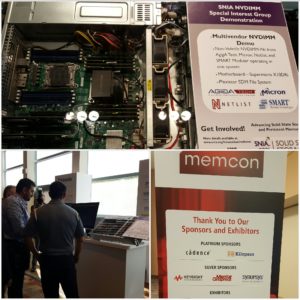SNIA thanks and celebrates the many hardworking SNIA member volunteers whose technical work was awarded Best of Show at the recent Flash Memory Summit.

SNIA won the FMS Most Innovative Flash Memory Technology Award, recognizing innovations that will change the way flash memory works and is used in products, for the SNIA Technical Position Real World Storage Workloads Performance Test Specification (RWSW PTS), developed by the SNIA Solid State Storage Technical Work Group (SSS TWG). “Real World Workloads are important for Data Center, IT, and Storage professionals,” said Eden Kim, Chair of the SSS TWG, and CEO of SNIA member company Calypso Systems “because real world workloads are very different from synthetic lab workloads and are key determinants in datacenter server and storage performance, optimization and qualification.” Eden and Jennifer Dietz of SNIA member company Intel and Co-Chair of the SNIA Solid State Storage Initiative Marketing Committee accepted the award from Jay Kramer of Flash Memory Summit.
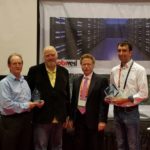
SNIA also won the FMS Best of Show Technology Innovation Award, recognizing that cloud and other large data centers typically prioritize their selection criteria for storage solutions as those that can achieve the highest possible performance while avoiding proprietary vendor lock-in. SNIA and EXTEN HyperDynamic™ NVMe over Fabrics high-performance storage software were recognized for creating an open storage management specification that works with EXTEN storage software for being the first in the industry to provide a solution based on SNIA Swordfish™ and DMTF Redfish® specifications. “We congratulate EXTEN Technologies for its innovation and well-deserved accolade,” said Don Deel, SNIA Storage Management Initiative Governing Board Chair. “By integrating SNIA Swordfish into its solution, EXTEN Technologies’ customers will benefit from a standards-based API that does not require learning the intricacies of storage infrastructure to handle day-to-day storage needs.” Accepting the award for SNIA at FMS were Mark Carlson of SNIA member company Toshiba Memory Systems and Bill Miller of SNIA member company Samsung Electronics, Co-Chairs of the SNIA Technical Council.
Congratulations to all the SNIA volunteers who participated in the development of these award-winning specifications.
SNIA Sessions at FMS Now Available for Viewing and Download
Also at Flash Memory Summit, SNIA work and volunteers were on display in sessions on persistent memory (PM), solid state storage, form factors, and testing. A two-day PM track featured talks on advances in PM, PM hardware, PM software and applications, and remote persistent memory (PMEM-101-1; PMEM -102-1; PMEM-201-1; and PMEM-202-1).
SNIA is now partnering with the Enterprise and Datacenter SSD Form Factor Working Group (EDSFF) on form factors and a Wednesday session outlined their advances (SSD-201-1). SNIA also presented a preconference seminar (G) on bringing your SSD testing up to date, and a SNIA Education afternoon with sessions on flash storage, programming and networking, buffers, queues, and caches; and a BoF on PM futures. Check out all these sessions and more on the Flash Memory Summit proceedings page.
SNIA Executive Director Michael Oros shared SNIA strategic directions and areas of focus in a FMS main stage presentation, available here.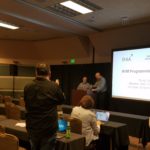
SNIA also presented updates on their work in Persistent Memory, Solid State Storage, and alliances at a well-attended reception on Monday evening. The SSSI honored Doug Voigt, co-chair of the NVM Programming Technical Work Group, for his contributions to SNIA and the NVM Programming Model.
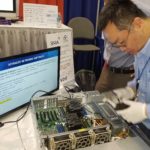 We continued our discussions on the exhibit floor featuring JEDEC-compliant NVDIMM-Ns from SNIA Persistent Memory and NVDIMM SIG members AgigA Tech, Micron, Netlist, SMART Modular Technologies, and Viking in a Supermicro box running an open source performance demonstration. If you missed it, the SIG will showcase a similar demonstration at the upcoming SNIA Storage Developer Conference September 24-27, 2018, and the SNIA Persistent Memory Summit January 24, 2019 at the Hyatt Santa Clara. Register now for both events!
We continued our discussions on the exhibit floor featuring JEDEC-compliant NVDIMM-Ns from SNIA Persistent Memory and NVDIMM SIG members AgigA Tech, Micron, Netlist, SMART Modular Technologies, and Viking in a Supermicro box running an open source performance demonstration. If you missed it, the SIG will showcase a similar demonstration at the upcoming SNIA Storage Developer Conference September 24-27, 2018, and the SNIA Persistent Memory Summit January 24, 2019 at the Hyatt Santa Clara. Register now for both events!
